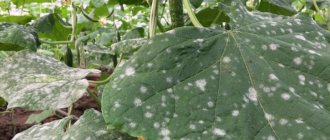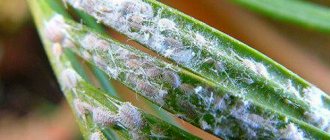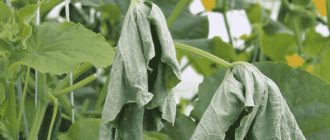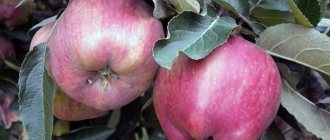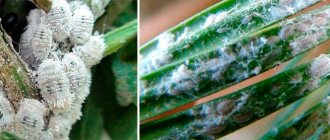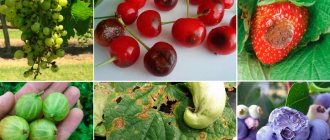Nutrient deficiency
The main reason for leaf discoloration is a lack of magnesium or potassium. Because of this, red and dry spots begin to appear on the plant. In this case, at first only the edge of the leaves is affected, and the rest of them begins to turn yellow only after a few days.
With a serious lack of magnesium, the leaf blades between the veins are first affected. The lower leaves are the first to change color and only after that the lower leaves of the cucumbers become covered with spots.
If the problem arose due to a deficiency of nutrients, then you should use a medicinal onion infusion. To prepare it, 100 g of husk is added to 10 liters of water. Then all this is thoroughly mixed and boiled for about 20 minutes. When the prepared mixture has cooled completely, you can begin treating the cucumbers. Each bush is treated with a liter of prepared infusion.
Causes of yellow spots on leaves
Yellowing can accompany the plant at any stage of the growing season. With the growth and development of cucumber culture, the list of reasons that lead to the appearance of spots gradually expands.
The main factors provoking the appearance of the problem are considered to be violation of the rules of care and external influences:
- Sunburn. This is the obvious cause, which is characterized by the appearance of dry yellow spots. Typically, a burn is easy to recognize. Often, seedlings are placed on windows where there is a high probability of direct sunlight. If the crop is in the garden, the cause is daytime watering. Moisture is retained on the leaves, causing burns after evaporation.
- Insufficient lighting. For this reason, the lower leaves most often begin to turn yellow. Due to the growth of the crop, they lack sunlight.
- Temperature jumps, low temperatures. The influence of temperature on cucumber crops is great. Low temperatures can lead to the appearance of extensive yellow-brown spots.
- Lack of nutrients in the soil. The leaves begin to become covered with spots during the period of active growth, color gain, and ovary formation. They especially need additional feeding.
- Violation of the watering regime. This case leads to the formation of yellow spots, and then to yellowing of the entire leaf. Excessive watering leads to rotting of the roots, which leads to stunting of the growth and development of the remaining parts of the plant. Insufficient watering provokes dehydration of plant parts with accompanying yellowing. They gradually dry out.
- Violation of the integrity of the root system. This may be due to pests that prevent the roots from developing, or due to rough handling of the roots during planting.
- The appearance of pests. This is a reason that becomes especially dangerous when parasitic insects actively reproduce. The appearance is indicated by yellow spots, which may be covered with brown dots, red streaks, and also have other signs that are most characteristic of a particular species.
- Diseases of cucumbers. Yellowing of leaves is most often caused by fungal diseases, which can be difficult to cure.
See also
The best way to feed cucumbers during flowering and fruiting
Read
Lack of light
For this reason, the color change occurs at the lower layer of foliage. If the thickets are quite dense, there are no other symptoms, this sign does not affect the amount of harvest, the damaged dying parts should be carefully removed.
Advice! If the problem of yellowing leaves concerns seedlings, then the placement system should be reconsidered.
Improper watering
Violation of the development of the root system leads to gradual withering and yellowing of parts of the crop. To avoid this, follow the rules in which the soil is watered several times a week, avoiding overwatering and drought.
Fungal diseases
The development of fungus on cucumbers is associated with several factors:
- defects in planting material that contributed to the development of fungus;
- spread of fungal microorganisms from neighboring crops by wind;
- presence of fungus in the soil.
Fusarium
This is a disease that affects plantings in a greenhouse. The main symptom is wilting of leaves with simultaneous yellowing at the edges. The danger of the disease lies in its rapid spread - the bushes can die within a few weeks without a timely response.
Root rotting
This disease begins to affect the plant from below. The root becomes covered with rot, it cannot supply the stems with nutrients and does not conduct moisture. This leads to wilting and yellowing of the foliage. This disease is difficult to diagnose. If symptoms are present, stop watering, loosen the soil and fertilize it with tobacco leaves.
Cladosporiosis or brown spot
The fungus is recognized by the appearance of yellow and brown spots; damage in the form of specks forms on the leaves. Favorable conditions for the development of the disease:
- temperature fluctuations;
- cold night;
- a large amount of dew falls.
Pests
Parasitic insects cause a lot of trouble; they are fought throughout the entire growing season of cucumbers.
The most common pests of cucumber crops are:
- whitefly;
- spider mite
The first signs of their reproduction are yellowing and wilting of the leaf blades. The whitefly is easy to spot on the inner surface of the plate due to its white wings. The appearance of spider mites is associated with the release of sticky white cobwebs. The mite itself is very small and difficult to see, so it is recommended to save the plants by completely treating all neighboring bushes.
See also
Description of the Ajax cucumber and recommendations for growing the hybrid
Read
Fertilizer shortage
Improper planning of fertilizing leads to wilting, curling and yellowing of leaf blades.
Information! With intensive growth, plants begin to experience a lack of magnesium, phosphorus, and potassium.
In order to correct the situation, experienced summer residents recommend applying complex fertilizers.
Mosaic virus
Cucumber mosaic virus is a special disease. It develops regardless of compliance with the rules of care. To begin development, cucumbers need to experience temperature changes for several days.
Greenhouse cucumbers are most often susceptible to the virus. Main features:
- marble yellowing of plates;
- twisting;
- shallowing;
- fall of the ovaries.
The virus cannot be treated; it should be prevented through preventive measures.
Downy mildew
This is a fungal infection that develops when watering rules are not followed, when there is heavy rainfall, or temperature changes.
The main difference between downy mildew and powdery mildew is the nature of the spots. With powdery mildew, they are brown in color; with downy mildew, dry yellow spots, reminiscent of burns, form on the plates.
Downy mildew
Spots on the leaves of cucumbers in the greenhouse and outdoors may appear due to powdery mildew. To find out that the plant has turned yellow precisely from peronosporosis, you should study its main symptoms. When this disease occurs, only the lower part of the bushes is the first to suffer. A faint gray coating with a slight purple tint appears on it. A few days after the onset of the disease, the spotting begins to spread throughout the entire bush.
The leaves gradually dry out and over time, because of this, the plant may die completely.
Most often, spots on cucumber leaves due to powdery mildew appear when grown in conditions of high humidity. Therefore, before treating yellow spots on cucumber leaves, you should lower the humidity level.
To protect cucumbers from the appearance of peronosporosis, you need to:
- water the bushes with heated and settled water;
- harvest the ripe crop in a timely manner;
- monitor crop rotation.
When the first signs of disease appear, you should immediately stop watering the plants and treat them with Bordeaux mixture. You can also use polycarbacin during treatment.
Life activity of insect pests
Cucumber foliage becomes spotted in areas damaged by thrips, spider mites or greenhouse whiteflies. If the insects are not destroyed, the bushes reduce productivity, wither and die.
IMPORTANT! Pests are especially dangerous for cucumber seedlings and adult plants in closed ground, where they spread at the highest speed.
Common spider mite
The size of an adult insect does not exceed 0.43 mm, but it is easy to notice the results of its harmful “work” on the leaves of cucumber plants. Ticks begin to move and feed at air temperatures above +12 degrees, and reproduce most quickly in dry heat (temperature +30 degrees, air humidity up to 55%). This pest damages cucumber seedlings on a window or glass balcony, as well as adult greenhouse plants. In street beds it is found on cucumbers only in hot, dry weather. Numerous insects colonize the underside of cucumber leaf blades, pierce them and suck out the juices.
Signs:
Dotted whitish-yellow spots appear on the leaves of cucumbers, which then merge into stripes and give a pale marbled color. Leaf petioles, shoot tips and other parts of plants are entwined with noticeable cobwebs. The cucumber leaf withers and falls off.
Control measures:
- There are biological insecticides (Fitoverm, Biokill, Iskra Bio) that successfully destroy mites and can be used even in the fruiting phase of cucumbers: the waiting period before harvesting is 1 - 3 days. The underside of the leaf blades should be sprayed especially generously.
- If the pest has just begun to spread, sometimes treating cucumber plants with a folk remedy - an infusion of crushed heads of garlic (100 g per 5 liters of water) helps.
Expert opinion
Stanislav Pavlovich
Gardener with 17 years of experience and our expert
Ask a Question
INTERESTING! Repeatedly dousing the bushes with cool water is effective against mites (the method is good for seedlings).
Western flower thrips
Yellowish or brownish individuals about 1 mm in size are located en masse on the leaves and other parts of greenhouse plants, piercing them to feed.
Signs:
On top of the cucumber foliage, small but numerous yellowish-white spots of dying tissue are noticeable. If you look closely, you can see crawling pests. The development and fruiting of cucumbers is sharply inhibited, the ovaries crumble, and the leaves gradually die off.
Control measures:
- Biological insecticides (Biokill, Fitoverm) are used on fruiting cucumbers.
- Cucumber seedlings can be watered and sprinkled with Aktara.
Greenhouse whitefly
This is the most harmful pest of greenhouse cucumbers. Small (up to 1.5 mm) white-winged moth and its larvae actively settle on leaves from below and feed on plant sap.
Signs:
The foliage becomes massively covered with small light spots, then turns yellow and flies off. Disturbed adult whiteflies fly in flocks. Sticky discharge and black spots appear on cucumber plants - insect waste. Cucumbers stop bearing fruit and gradually die off.
Control measures:
- Yellow glue traps are hung in cucumber greenhouses.
- A biological product, Verticillin, has been created against whiteflies (85% effective), but there are difficulties in acquiring it.
- Adult insects and larvae die when plants are repeatedly sprayed with pesticides containing the active ingredient imidacloprid (Confidor Extra, Confidelin, etc.). The waiting period before possible harvesting is determined at 3–5 days. Insecticides Mospilan and Stozhar destroy oviposition.
Expert opinion
Stanislav Pavlovich
Gardener with 17 years of experience and our expert
Ask a Question
If small yellowish spots are noticeable on the leaves of cucumbers (especially in a greenhouse), the first thing you need to do is check the bushes for pests. They can usually be seen on the underside of leaf blades. Having excluded this factor, damage due to diseases should be assumed.
Cladosporiosis
Sometimes, the leaves turn yellow due to the fact that the plant suffers from cladosporiosis. This fungal disease of cucumbers has pronounced symptoms and therefore it is quite easy to distinguish it from other diseases.
See also
How to blind cucumbers in open ground and greenhouseRead
At the initial stage, small round dots appear on the leaves. At first their size is only 1-2 mm, but after two days they begin to enlarge and dry. At the slightest touch with your hand, the inclusions that appear are destroyed.
To prevent cladosporiosis it is necessary:
- plant cucumbers in a new place every year;
- regularly ventilate cucumbers in the greenhouse;
- When watering, use only heated water;
- Before planting cucumbers, completely clear the area of the remains of plants that were previously grown on it.
If yellow spots have already appeared on the plants due to cladosporiosis, you should immediately stop watering for a week. For treatment, it is recommended to use foundationazole or Bordeaux mixture.
Diseases of cucumbers in a greenhouse
Like all crops, cucumbers are susceptible to diseases, regardless of where they are cultivated. However, a number of diseases develop primarily in greenhouses. These are: Ascochyta blight, Cladosporiosis, Root rot, Mosaic, Powdery mildew, Downy mildew, Fusarium blight and others.
Favorable factors for this will be:
- perennial soil;
- poor ventilation and agricultural technology;
- excessive humidity;
- violation of the irrigation regime.
Diseases can be prevented by following the recommendations of agronomists:
- do not plant cucumbers after squash crops;
- water only with warm water and at the root of the plant;
- tie up bushes on time;
- Thoroughly disinfect the greenhouse before and after harvesting.
Anthracnose
Yellow spots on cucumbers in the greenhouse and in the garden often appear due to anthracnose. Most often, anthracnose appears due to the fact that undisinfected seeds were planted. The plant can also become infected due to a fungus in the soil.
When this disease appears on cucumbers, several inclusions of red color can be seen near the veins. Literally 2-3 days after infection, the leaves begin to dry quickly, and dark ulcers appear on the fruits.
Getting rid of the disease is quite simple. To do this, treat the plants with Bordeaux mixture and a weak solution of copper sulfate once a week. Some vegetable growers then sprinkle the cucumber bushes with lime or charcoal.
Treatment options
Gardeners themselves decide which methods to use: spray with chemicals or use traditional recipes. But still, first you need to take care of normal lighting, and also remove damaged parts, tie up the vines so that sunlight falls evenly on them, and cut off interfering branches. If yellowness appears on young seedlings, they are thinned out or replanted.
Humidification must be stable. It is recommended to water once every 2-3 days, depending on weather conditions. The water norm for 12 m is 1 bucket. If you can’t come to the garden plot more often, cover the bed with agrofibre to reduce evaporation, or sprinkle it with mulch.
In case of heavy rains, mulch made of sand or sawdust that absorbs water will also help. The top layer of soil is loosened to increase evaporation. Water either in the morning or after 17-18 hours, directing the stream under the roots. As already mentioned, due to splashes falling on the lashes, spots form on cucumbers and leaves.
Attention!
It is advisable to preheat the water to room temperature. To do this, you need to fill the tank in advance.
Control of plant diseases
To cure a plant if it is infected with fungal diseases, it must be treated from roots to top shoots:
- To combat powdery mildew, Topaz, Fundazol, Fitosporim, and bacterial biofungicides are used. The safest biological products are Rizoplan, Gamair, Alirin-B and the like. If there are always children and pets on the site, it is better to use folk remedies. For example, spray with a soap-ash solution: half a glass of ash and 100 g of laundry soap in a bucket of water, leave for 2 days. Another method is treatment with whey or sour kefir.
- Treating anthracosis using home recipes is ineffective; chemicals are needed. This group includes Ridomil, Quadris, Skor, Acrobat, Oxycom.
- To suppress the spread of cladosporiosis, plantings must be treated with copper preparations. These include Bordeaux mixture and Hom. Folk remedies will help only at the first signs of the disease. Mix 2 liters of milk, 60 drops of iodine, 40 g of grated soap, leave for 6 hours, spray the plant every 10 days until the ovaries. Another method is to pour 50 g of crushed garlic into 1 liter of warm water and leave for 24 hours.
- To treat Alternirosis developing on cucumbers planted in open ground, the same means are used as against Cladosporiosis. At the first symptoms of the disease, Polyram is used in the greenhouse.
Attention!
You should not eat cucumbers that are infected with fungal diseases, wrinkled or stained.
Even if the plant was saved, after the end of the gardening season all the vines should be burned, the bed should be cleared, and re-treated with chemicals. Cucumbers can be planted no earlier than after 4 years. When using fungicides, strictly follow the instructions.
Insect extermination
Gardeners prefer to fight pests with folk remedies. The most effective ways:
- Against spider mites - spraying with a solution of laundry soap or ammonia.
- Aphids do not like strong odors. Plants are treated with infusion of tobacco or citrus peel. To make a “medicine” from tobacco, take it out of a pack of Prima, add 5 liters of water, and let it sit for a day. A saturated solution of dried lemon or orange peels is made as follows: pour the peels (0.5 liter jar) with 1 liter of boiling water, let it stand for a day, and then boil for 10 minutes. Before spraying, dilute in 10 liters of water.
- Traps will help you cope with whiteflies. You can hang sticky fly tape or pieces of cardboard coated with a mixture of honey and vegetable oil.
- Sprout fly. These pests cannot be controlled without insecticides. Fufanon and Detox are used for spraying, and Iskra and Attelik are used for seed dressing. Cyperus has a wide spectrum of action.
- Slugs are collected manually, and the beds are treated with liquids with a pungent odor or bioinfusions made in industrial conditions.
Important!
All chemicals must be used with caution. They are dangerous not only for pests, but also have a negative impact on children and pets.
To prevent the leaves from turning yellow, you need to feed the area where you plan to plant cucumber seedlings in the fall. They use organic matter, humus, wood ash or silage, and water it with urea. If you encounter a problem after planting, you can use this method: dissolve 25 g of ammonium nitrate in a bucket of water and water the bed 2-3 times with an interval of 7-10 days. To enhance the effect, the soil is treated with a solution of Nitroammophoska. Dilution proportions: 1 tbsp. l./8-10 l of water.
Field mosaic
There are cases when cucumber seedlings begin to gradually turn yellow due to infection with field mosaic. This disease appears equally often both in greenhouses and in vegetable gardens. On each leaf of bushes infected with this disease, at least one yellow spot appears near the vein.
If you do nothing, then over time the entire bush will become covered with such spots. This reduces the number of flowers, causing the yield to deteriorate. To cure field mosaic, it is enough to treat the bushes with whey several times a week. The procedure is carried out until the leaves begin to recover.
General recommendations
Although there are individual recommendations for each case of yellowing, there are several general rules that can help you cope with the problem and prevent its occurrence. If yellow spots appear on the leaves of cucumbers, first of all you need to find and eliminate the cause. But sometimes prevention allows not only to reduce the number of diseases and lesions, but also to prevent them altogether.
- The planting cycle must be followed. Crop rotation and alternation of areas allows you to prepare the soil and avoid the appearance of larvae and weeds. Change planting sites and do not use the same one every year. Alternate cucumbers with legumes.
- Follow watering standards. It is best to do this 3-4 times a week, in careful doses. An automatic irrigation system or a layer of mulch that reduces the rate of moisture evaporation will help solve the problem.
- Carry out prevention: spray the plantings with anti-pest agents, use mild chemicals and folk remedies.
- Immediately burn plants damaged by viruses and treat neighboring bushes to prevent spread. It is almost impossible to cure viruses.
- Inspect plants regularly for diseases or pests. The sooner you notice a problem, the easier it will be to solve it.
Try to loosen the soil more often, regularly use preparations against harmful insects, remove weeds and plant debris in a timely manner, and do not forget about proper care. Pest and disease control requires an integrated approach. But yellow leaves are not always a disease; the cause may be hidden in a lack of nutrients, lack of moisture or light. Follow crop rotation and care recommendations - and then there will be no problems with cucumbers in your garden.
Topaz
Using this fungicide, you can quickly get rid of fungal diseases that cause the cucumber leaves to become covered with spots. This remedy is also often used to prevent these diseases. The main advantage of Topaz is that it is non-toxic and therefore cannot harm human health in any way.
This product is available in various forms. Most often it is sold in the form of a blue powder or liquid solution. When using powder, you will have to prepare a working solution. To do this, 10 g of the drug must be mixed with 10 liters of water. At least two liters of the mixture should be consumed per ten square meters of area.
See also
The best varieties of cucumbers for open ground in the middle zone and when to plant themRead
Hom
Some vegetable growers use Hom after the cucumbers begin to become covered with yellowish spots. Most often it is used as a replacement for Bordeaux mixture. This remedy is very effective in combating many different fungal diseases. The drug contains copper oxychloride, which has a contact effect. When this substance gets on the surface of the leaves, it prevents infectious agents from penetrating the plant tissue.
Khom is sold in the form of a green powder, which must be dissolved in water before use. To do this, 30 g of fungicide is mixed with 5-7 liters of water and left for half an hour. It is recommended to use Hom once a week in calm weather. If spots appear on almost every leaf, then you need to use the mixture more often.
Fruit diseases
What kind of disease is it when cucumbers turn yellow?
One of the reasons for the yellowing of plant fruits is the cucumber mosaic virus. Your cucumbers are infected with it if you notice wrinkled, wilted, spotted leaves and spots on the fruit. They range from pale white to yellow in color with a soft texture.
Mold on cucumbers
It can be caused by the disease white rot, another name for which is Sclerotinia. The reasons and ways to combat this disease are below.
Mold is also part of the symptoms of powdery mildew disease. Which was mentioned above.
White rot of cucumbers
This infectious disease is caused by the marsupial fungus Sclerotinia. It most often develops in early spring and autumn. At this time there is a lack of heat and excess moisture. The disease develops at a temperature of 12-16 degrees. It affects all parts of the plant. The affected surface begins to become wet and becomes covered with a cottony coating.
Struggle:
- remove diseased plants;
- Treat partially damaged areas with a mixture of soap and copper sulfate in a 1:1 ratio.
Cucumber embryos rot
Rotting cucumber ovaries is associated with the disease brown spot. Another name for the disease is Cladosporiosis.
Dark spots appear on the embryos. As the fetus grows, their size increases. The cucumber is covered with a swamp-green coating.
Cladosparia blight on cucumbers
The problem can also be caused by cucumber diseases - gray and white rot.
Cucumbers are lumpy, what kind of disease?
Viral plant diseases contribute to fruit deformation. It can be green and white mosaic. The disease can develop after a sharp jump in temperature to +30 degrees.
The leaves of the plant become wrinkled, the number of female flowers and fruits decreases. The ovaries develop more slowly, the fruits become deformed. They acquire a mosaic color and lose their taste.
Zircon
You can get rid of appearing spots with a yellowish color using Zircon. This drug not only protects young bushes from diseases, but also activates their growth. Zircon can be used at any stage of cucumber development. Many vegetable growers even use it during pre-sowing soil preparation, before planting in greenhouses.
The product is absolutely safe for people, since it contains no chemical components and the drug consists only of elements of plant origin.
Before curing the yellowing of the leaves, you should prepare a working mixture. To do this, the container is filled with 2-5 liters of water, after which 25 g of the drug is added to it. Then the mixture is mixed and poured into a ten-liter bucket of water. The finished substance is used once a week until the bushes are completely restored.
Preventing yellowing of leaves
To prevent the leaves of cucumber vines from turning yellow in hot weather, you need to ensure that the soil does not dry out and that air is supplied to the root system. To do this, the beds are regularly watered, after heavy rains, excess water is drained, and the soil crust is loosened. The planting material is disinfected and the beds are treated with fungicides. Remove weeds and dried leaves in a timely manner. Thin out thickets that are too dense if the seedlings have sprouted in a crowd.
Spraying is carried out not only when problems arise, but also for preventive purposes. As soon as the seedlings have taken root and the first leaves (3-4) have appeared on it, they are treated with a solution based on grated laundry soap, iodine, and milk. Proportions: 20 g/3 drops/1 l. Dilute in a bucket of water, spray the plant 3 times every 10 days. When flowering begins, the lashes are treated with an alkaline solution - 1 tbsp. l. soda for 1 bucket of water. These measures will help prevent fungal infection.
To prevent nutrient deficiency, fertilizers are applied (before use, you should read the instructions). If cucumbers are planted in a greenhouse, it is necessary to maintain a constant temperature and humidity and control the lighting. A timely response to changes in leaf color will help preserve the harvest.
Oksikhom
If cucumbers have small brown spots on the leaves, then you should use Oksikhom. With its help you can protect plants from various diseases or cure them. The main advantages of the drug include its long therapeutic effect. After using this remedy for yellow spots several times, you can forget about fighting them for a long time. After penetrating the leaves, Oxychom acts on almost all the most important components of the fungal cells that lead to the yellowing of the leaves.
The drug is sold in powder form, and therefore before use it is worth preparing a working solution. 20-40 g of the drug is added to a filled ten-liter container. All this is thoroughly mixed and poured into smaller containers. The product is used once every two and a half weeks.
How to prevent the disease from appearing
Proper implementation of agricultural practices will help avoid many problems with cucumbers. Timely inspection and proper care help to avoid minimizing the risks of yellowing of leaves.
For prevention purposes, follow simple rules:
- Regular watering.
- Constant change of landing site.
- Preventative treatment to prevent the spread of fungus.
- Timely loosening of the soil and removal of weeds.
- Fertilizing with complex fertilizers.
- It is necessary to monitor the density of plantings and thin out.
- Cleaning up fallen and damaged leaves.
- Protection from temperature changes and other natural disasters.
If you follow all the rules for caring for cucumbers, the appearance of yellow leaves is minimal. But when such a problem is detected, the growth conditions, the agricultural practices performed and the condition of the green part of the plant are analyzed in order to urgently take measures to treat the plants. If yellow spots on the leaves appear on cucumbers, don’t think about what to do. Only correctly identifying the cause will help you understand how to treat it.

